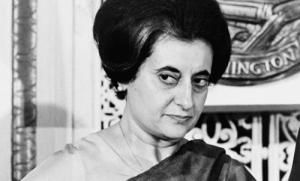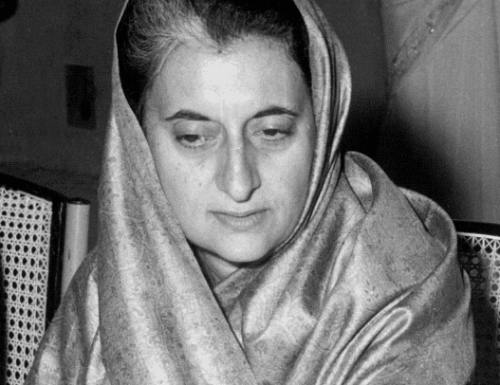Indira Gandhi: The Iron Lady of India

Today we’re going to talk about a very controversial character. Loved and hated almost equally, this woman led her country in times of great trouble. Indira Gandhi is unknown to younger generations. So we wanted to take a look at her life as the great political figure she was.
Indira Gandhi was the first woman to hold the position of Prime Minister in India. Her mother was a human rights defender of the less fortunate. Her father, Jawaharlal Nehru, was the leader of the independence movement against the British Empire. Later, he became the Prime Minister of India.
During Indira Gandhi’s political career, she confronted the world’s greatest powers. Additionally, she was the one who converted India into the fifth country with nuclear power. Her work as the first female political figure in India is full of ups and downs. At any rate, it was no bed of roses.
Her early years
She was born in Allahabad on November 19, 1917. As a child, she admired Joan of Arc. Unfortunately, her mother died when Indira was still very young. Furthermore, her dad lived away from her because of his complete dedication to the politics of the country. Thus, she inherited her political vocation from her father. From an early age, she knew she wanted to serve her country.
For some time, some great personal tutors educated her in her house. Later she attended a Christian school in Delhi before going to Geneva. Then she tried to complete her studies at Oxford after her mother died. Finally, World War II broke out and thwarted her academic aspirations.
During her time at Oxford, Indira Gandhi became close friends with the man who would become her husband, Feroze Gandhi. In March 1942, they married and soon had two children. After a brief romance, her marriage would fall apart due to her husband’s infidelities.

The political rise of Indira Gandhi
Back in India, Indira Gandhi became interested in politics. So, she began to work with her father, Prime Minister of India at the time, becoming his right hand.
Soon she joined the Congress Party and actively supported her father in the struggle for Indian independence. Of course, Mahatma Gandhi headed the movement, with whom she has no ties, despite sharing a last name. India achieved its independence from British rule on August 15, 1947.
During the first years of Indian independence, her political career progressed hand in hand with her father’s, until he died in 1964. Indira Gandhi began to take on different ministerial roles, always at the front ranks of the political environment in India.
In 1966, Indira’s colleagues proposed her as General Secretary of the Congress party. Soon afterward, she would become the new Prime Minister of India. Thus, she became the first woman in India to hold a political position of that caliber.
Some of her biographers emphasize that Indira Gandhi was elected prime minister by her party in an attempt to have someone they could manipulate. They only wanted someone whose main function would be to be the image of the party. But, they didn’t want her participating in important decision-making.
However, it’s certainly true that she didn’t have the same plans. Of course, this gained her many enemies among her ranks from the very start.
The policies of Indira Gandhi
She was elected Prime Minister on two occasions. First, from 1966 to 1977. Later she would serve from 1980 until her assassination in 1984. Indira Gandhi’s first term as Prime Minister of India was marked by her progressive policies. Furthermore, she made a tremendous effort to strengthen the ties between non-aligned countries.
This stance was clearly very progressive, which caused many threats from her own party. Despite those threats, she carried out agricultural modernization programs. Among some of those that stand out are the Green Revolution and White Revolution proposals. These proposals sought to protect seeds, crops and dairy production in order to end malnutrition in India.
Furthermore, she also developed nuclear and space programs. Additionally, she had many victories in the war against Pakistan which led to the creation of Bangladesh. Her foreign policy strategies put her at serious odds against American interests in the area. Richard Nixon used to refer to her as ‘the old witch.’
Fraud, dislike, and corruption
Even so, in 1971, after her last elections, Indira Gandhi was unable to fulfill many of her electoral promises. The Gandhi administration was beginning to take tremendously unpopular measures. Moreover, they were accused of corruption and electoral fraud.
These events caused great tension in India. Thus Indira Gandhi was ordered to resign from her position as Prime Minister, and she was additionally disqualified to run for the position for six years.
Gandhi believed she was the victim of a conspiracy against her so she refused to resign from the position. Then, in 1975, she decreed a state of emergency in India. With support from her son, she censored the press and imprisoned her opponents.
In addition to all this, her ambitious son, Sanjay, launched a mass sterilization program, claiming that India was too crowded to govern effectively. So, with all of these unpopular measures, the new elections kicked her and her son out of the Indian presidency.

Re-election and murder
Despite her fall from popularity, Indira was elected again in 1980. In that same year, her son Sanjay died in an airplane accident. During this new term as Prime Minister, her government confronted separatist demands from some states in India, like Punjab. This was a Sikh majority territory, whose spiritual leader began to violently harass the central power of India.
Some theories claim that countries which did not like Indira Gandhi’s policies secretly aided the separatist groups. In any case, the independence movements tested her patience. Finally, with an iron fist, she ordered Indian forces to capture the Golden Temple, which was the control center of the Sikhs.
This operation caused hundreds of deaths among the separatist Sikhs. Thus, it infused a visceral hatred for the Prime Minister and her government by the members of the community.
In 1984, two of her closest bodyguards shot her at point-blank range, murdering her in her home. It seems that both were undercover Sikh militants.
After the murder of Indira Gandhi, violence and persecution of Sikhs erupted in northern India. So a series of riots took place that claimed thousands of lives in India.
A questionable legacy
There are two very different legacies that Indira Gandhi and her government had on the country. On the one hand, she contributed very positively to the progress of India not only so that it would be an independent country but also self-sustaining. All this prompted India to become a world power.
On the other hand, to achieve her objectives, she didn’t seem to hesitate with any obstacle. She resorted to corruption and measures that, in some cases, were obviously wrong and misfortunate.
Throughout her trajectory in life and politics, the historical character of Indira Gandhi seems to take on different personalities and leadership styles. In fact, some studies in social psychology have tried to explain the relationship between her personality and leadership style.
In any case, she was a character full of moral ambiguity but, without a doubt, her life is worth learning about and studying.
“There are hopes that cannot be met, even in a lifetime (…). Now, the flames have been exinguished, the ashes are cold, and soon they will be collected in a bronze urn. It will be Rajiv who was to take them on a plane and spread them over the snow-capped mountains of Kashmir, according to her wishes, the mortal remains of Mother Indira, the most beloved and hated woman in India.”
-Paola Capriolo-
This text is provided for informational purposes only and does not replace consultation with a professional. If in doubt, consult your specialist.








